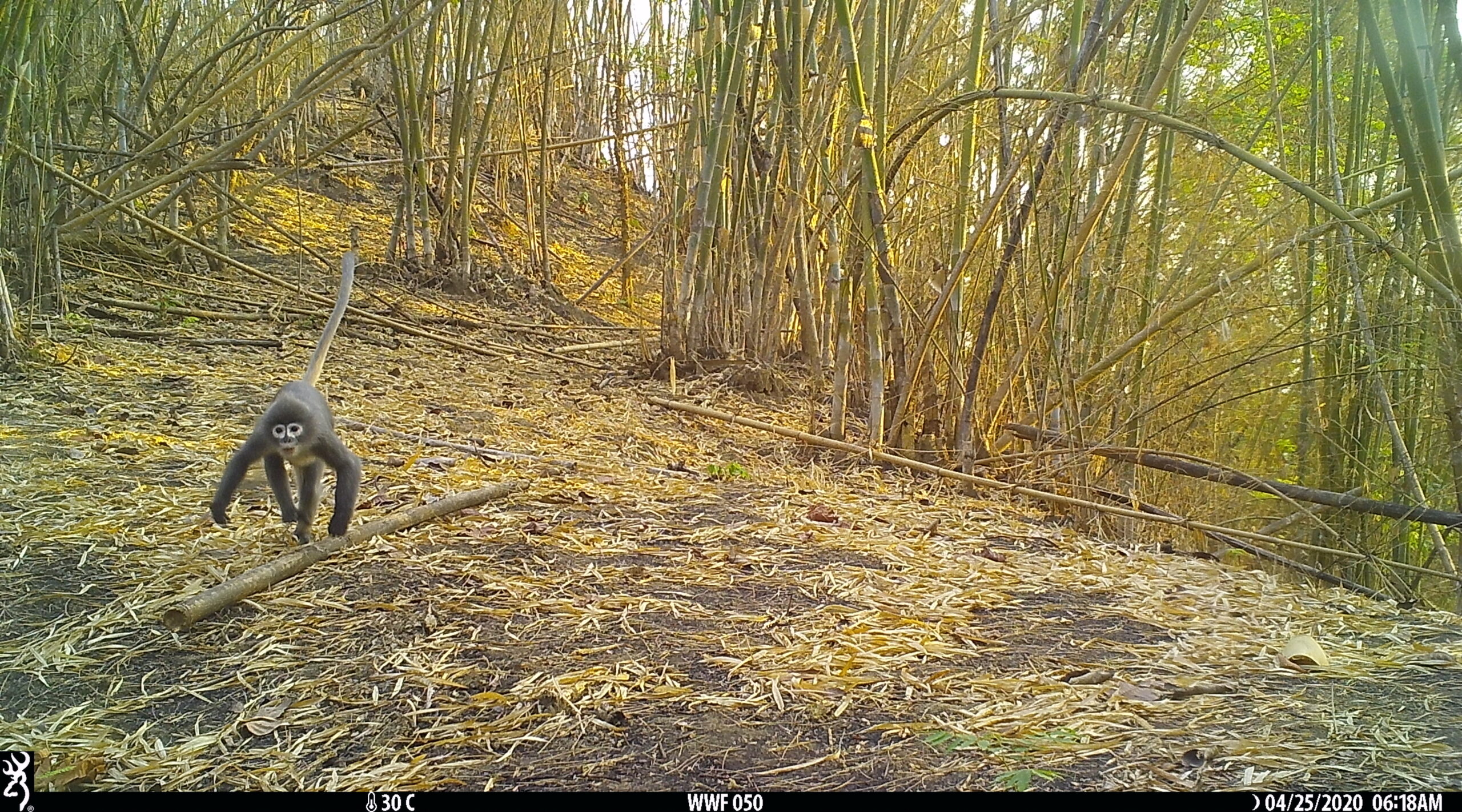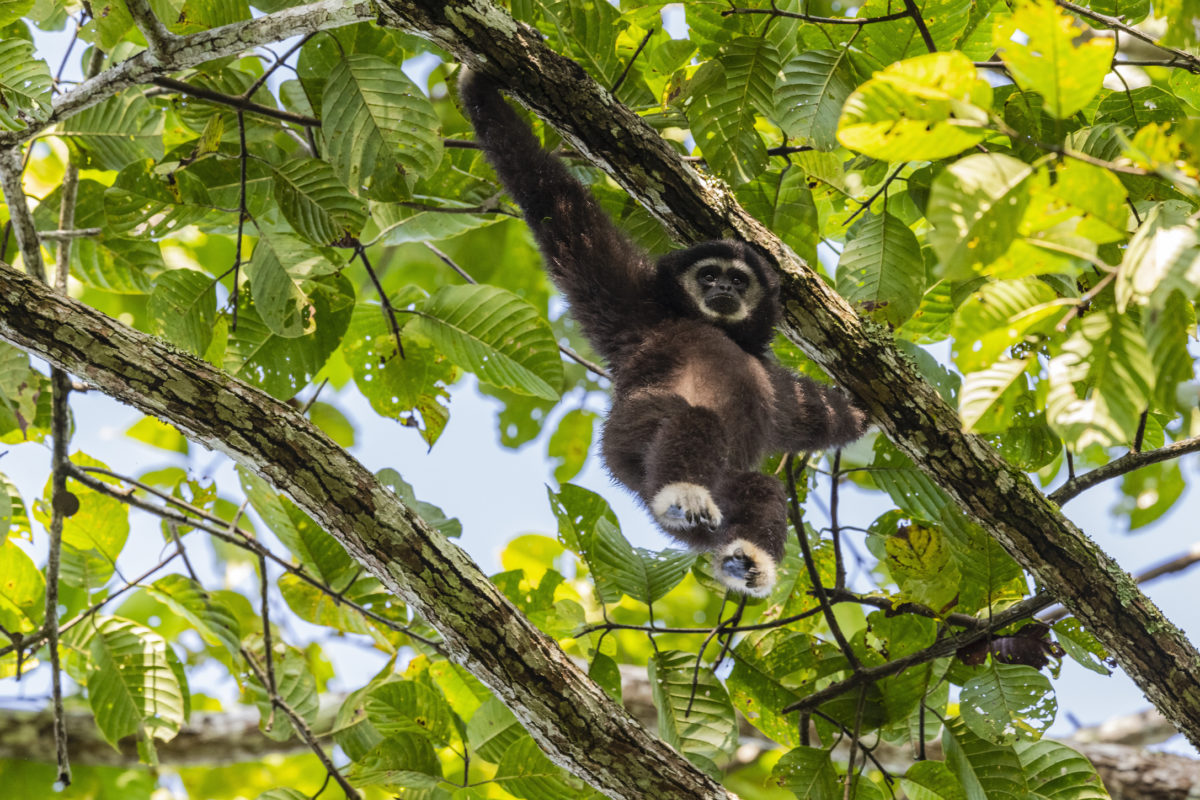- The Greater Mekong region is home to 44 species of non-human primates, including gibbons, lorises, langurs, macaques and snub-nosed monkeys, several of which were first described within the last few years.
- Habitat loss and hunting driven by the wildlife trade and consumption have driven many of the region’s primates to the brink of extinction, with many species now only existing as tiny populations in isolated, fragmented pockets of habitat.
- Experts say controlling the illegal wildlife trade is complicated by the presence of legal markets for primates, often for use in biomedical research.
- Despite the challenges, conservation action at local levels is achieving results for some primate species in the region while also enhancing livelihoods and ecosystem services for local communities.
When scientists described the Popa langur (Trachypithecus popa) as a species new to science in 2020, it was already staring extinction in the face. Fewer than 260 of the fluffy gray leaf-eating monkeys are estimated to remain across four precariously isolated patches of forest on Myanmar’s central plains, where their survival is threatened by habitat loss and hunting.
And the Popa langur is not alone in its plight. Some 90% of non-human primate species in the Greater Mekong region are listed as threatened with extinction (vulnerable, endangered, or critically endangered) on the IUCN Red List, according to a report published earlier this month by WWF.
Deforestation, habitat degradation, and hunting to supply the wildlife trade have driven many of the region’s gibbons, lorises, langurs, macaques and snub-nosed monkeys to the brink of extinction, the report says. It incorporates the latest updates to the IUCN species assessments, in which one-quarter of the primate species in the region were bumped to a higher category of threat.

Of the 44 species of primates in the Greater Mekong region, which spans Cambodia, Laos, Myanmar, Thailand and Vietnam, 12 are considered critically endangered. The global population of some endemic species are miniscule: for example, fewer than 100 Tonkin snub-nosed monkeys (Rhinopithecus avunculus) exist, exclusively in a tiny patch of limestone karst forest in Vietnam; and a surviving population of no more than 140 Cao-Vit black-crested gibbons (Nomascus nasutus) clings on in a wisp of forest on the China-Vietnam border.
Meanwhile, roughly half of species are endangered, including skywalker hoolock gibbons (Hoolock tianxing), a species that was only described in 2017 from eastern Myanmar and southwestern China, and pygmy slow lorises (Nycticebus pygmaeus), which are captured and traded as pets or killed for use in traditional medicines.
Primates are also at risk from human pathogens, like the coronavirus, that can be transmitted from people to animals, the report says, a threat that increases as habitats are further degraded and fragmented, forcing humans and wildlife into closer contact.

Trade lacks oversight
While most primates follow an arboreal lifestyle, enabling them to avoid the millions of snares that litter the region’s forests at ground level, many species still experience severe hunting pressure, according to Yoganand Kandasamy, regional lead for wildlife and wildlife crime at WWF Greater Mekong and co-author of the WWF report. This results in “empty forest syndrome,” whereby protected areas and forests exist, but are devoid of animals.
The motives behind hunting range from live capture of gibbons and lorises for tourism and the pet trade, to killing for food at a subsistence level and harvesting for body parts to use in traditional medicines.
Alongside habitat loss, the wildlife trade — both legal and illegal — severely threatens primates in the Greater Mekong: a 2017 study found that between 2005 and 2014, more than 450,000 primates were traded globally, with Asian species accounting for 93% of the trade.
A high proportion of trade in the region is domestic, says the report, but lack of formal monitoring and regulation and an increasing proportion of online transactions hamper experts’ attempts to gauge legality and impacts on wild populations.
“Concerned people mostly focus on international trade that is governed by CITES” — the international convention to ensure commercial wildlife trade doesn’t lead to species extinctions — “but trade within national borders is a huge threat and overlooked because we don’t have access to the data, we don’t know what the intensity of it is, and there are no national databases available,” Yoganand said.
In addition, there is a booming legal trade in captive-bred primates for biomedical, toxicological and pharmaceutical research. In the Greater Mekong region, long-tailed macaque “farms” in Cambodia, Laos and Vietnam export thousands of animals to research facilities in such regions as China, Europe, Japan and the U.S each year.
Although most of this international trade is documented through CITES and might look legitimate on the surface, “there are potentially huge illegalities, threats and risks associated with it,” according to Yoganand. In particular, the legal trade impacts wild populations since weak law enforcement and transparency enable traffickers to pass off wild-caught animals as captive-bred.
“Legal trade doesn’t mean it is sustainable, it doesn’t mean it is ethical, it doesn’t mean it takes care of animal welfare, or takes into account the risk of disease transmission,” Yoganand said, adding that regulatory gray areas that continue to facilitate exploitation of wild animals need to be clarified. “There are still a lot of shortfalls that need to be fixed, including monitoring protocols, independent checks, ensuring there is no laundering, better enforcement and credible non-detrimental findings.”

Targeted action
Yoganand said action at the local level has huge potential to reverse the trajectory for many of the region’s species. The fact that some species are very range-restricted means conservation efforts can be focused, local communities can be engaged, and limited budgets can go further, Yoganand said. “There’s been very good success stories of collaboration with local communities and successful conservation — the primates benefit and also the local communities get benefits out of it.”
For Paul Garber, a primatologist at the University of Illinois Urbana-Champaign, the alarming global decline in primate numbers is a wake-up call. When Garber and his colleagues published a review of the world’s primates in 2017, 60% of species were threatened with extinction. “Now, just five years later, that figure is up to about 66%, and I would argue that is still an underestimate; many species are data-deficient,” he told Mongabay in a recent interview.
Garber said corporations, governments and buyers in wealthy consumer nations must take responsibility for their complicity in the devastating conversion of natural habitats around the world that is driving biodiversity loss.
As our closest living relatives, primates afford critical insights into human evolution, biology, behavior and emerging diseases, Garber said. They also play a crucial role in maintaining the health of tropical forests through pollination and seed dispersal and as prey for top predators. Given that they’re among the first animal groups to be lost when ecosystems fall out of balance, they also serve as important indicators of overall ecosystem health.
As Garber describes it, primates “are the canary in the coal mine.” While we continue to degrade, pollute and destroy natural habitats, we will lose primates in the short term, but over time those ecosystems will become unusable to humans too. “Primates are foreshadowing what will happen to us if we don’t change what we’re doing,” he said.
Banner image: A gibbon photographed in the Dawna Tenasserim forest landscape between Thailand and Myanmar. Photo courtesy of Christy Williams / WWF Myanmar
Citation:
Estrada, A., Garber, P. A., Rylands, A. B., Roos, C., Fernandez-Duque, E., Di Fiore, A., … Li, B. (2017). Impending extinction crisis of the world’s primates: Why primates matter. Science Advances, 3(1). doi:10.1126/sciadv.1600946
FEEDBACK: Use this form to send a message to the author of this post. If you want to post a public comment, you can do that at the bottom of the page.
